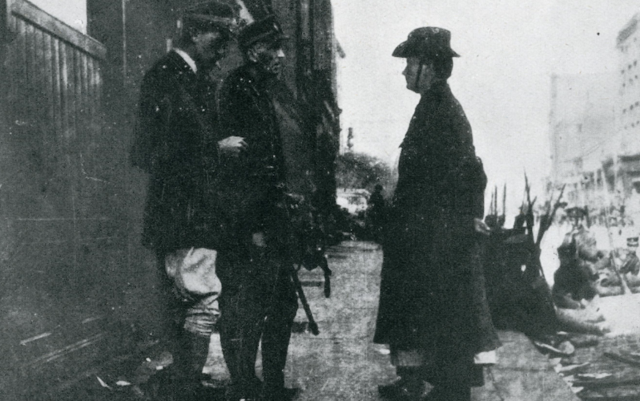Minister of State Christopher O’Sullivan welcomed the progress made on the conservation and refurbishment of the national monument at 14-17 Moore Street in Dublin during a visit to the historic site on July 17.
The project to transform the historic 1916 national monument into a commemorative visitor centre was initially due to open in 1916 for the Easter Rising's centenary anniversary, but has been plagued with a series of delays.
The structures at 14–17 Moore Street played a key role in the final days of the 1916 Easter Rising. After the surrender of the General Post Office (GPO) on O’Connell Street, the surviving rebel leaders retreated to Moore Street, where they made a last stand against the British.
Following his visit to the site on July 17, O’Sullivan, the Minister of State at the Department of Housing, Local Government and Heritage with special responsibility for Nature, Heritage and Biodiversity, said: “Today’s visit gave me a real sense of what the leaders of the 1916 rising went through as they tunnelled through these properties on Moore Street, ultimately making the decision to surrender on the 1st floor in number 16.
"The reason the state purchased 14-17 Moore Street was to conserve this historical site and create a commemorative centre. I want to see that delivered at pace.”
Highlighting the significance of the site, Minister O’Sullivan added: “Moore Street holds a unique and powerful place in the story of the 1916 Rising and in the history of Dublin city.
"The regeneration project is about honouring the legacy of those who fought for Ireland’s independence, preserving the authentic character of the national monument, and ensuring that future generations can connect with this pivotal chapter in our nation’s past.”

January 2016: Graffitti outside 16 Moore Street, depicting Padraig Pearse and two construction workers. The artwork shows graffiti artist Banksy's name. (RollingNews.ie
According to Ireland's Department of Housing, Local Government and Heritage, works for the stabilisation and protection of the monument have been ongoing. A design team has been appointed, and the detailed design of the exhibition has been approved.
Substantial construction is expected to begin in 2026, with the commemorative centre expected to open to the public in early 2028.
The project is structured in two phases. The initial phase focuses on the stabilisation, repair, and adaptation of the four historic buildings at Nos. 14, 15, 16, and 17 Moore Street, preparing them to house a 1916 commemorative centre.
The next phase involves constructing a new two-storey building over the existing basement cellar at Nos. 8–9 Moore Lane, to the rear of the Moore Street houses. This new structure will incorporate surviving external walls and provide expanded facilities for the commemorative centre, accessible from Moore Lane and the yard behind Nos. 15 and 16.
Both elements are designed to integrate into a single visitor experience, connected by a central external courtyard intended for reflection and commemoration.



Comments